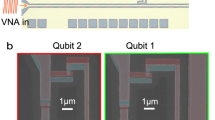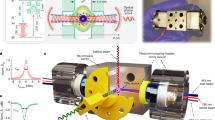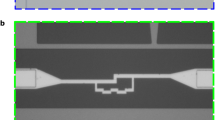Abstract
The study of light–matter interaction has led to important advances in quantum optics and enabled numerous technologies. Over recent decades, progress has been made in increasing the strength of this interaction at the single-photon level. More recently, a major achievement has been the demonstration of the so-called strong coupling regime1,2, a key advancement enabling progress in quantum information science. Here, we demonstrate light–matter interaction over an order of magnitude stronger than previously reported, reaching the nonperturbative regime of ultrastrong coupling (USC). We achieve this using a superconducting artificial atom tunably coupled to the electromagnetic continuum of a one-dimensional waveguide. For the largest coupling, the spontaneous emission rate of the atom exceeds its transition frequency. In this USC regime, the description of atom and light as distinct entities breaks down, and a new description in terms of hybrid states is required3,4. Beyond light–matter interaction itself, the tunability of our system makes it a promising tool to study a number of important physical systems, such as the well-known spin-boson5 and Kondo models6.
This is a preview of subscription content, access via your institution
Access options
Subscribe to this journal
Receive 12 print issues and online access
$259.00 per year
only $21.58 per issue
Buy this article
- Purchase on SpringerLink
- Instant access to full article PDF
Prices may be subject to local taxes which are calculated during checkout




Similar content being viewed by others
References
Haroche, S. & Raimond, J.-M. Exploring the Quantum: Atoms, Cavities, and Photons (Oxford Univ. Press, 2006).
Wallraff, A. et al. Circuit quantum electrodynamics: coherent coupling of a single photon to a Cooper pair box. Nature 431, 162–167 (2004).
Peropadre, B., Zueco, D., Porras, D. & García-Ripoll, J. J. Nonequilibrium and nonperturbative dynamics of ultrastrong coupling in open lines. Phys. Rev. Lett. 111, 243602 (2013).
Díaz-Camacho, G., Bermudez, A. & García-Ripoll, J. J. Dynamical polaron ansatz: a theoretical tool for the ultra-strong coupling regime of circuit QED. Phys. Rev. A 93, 043843 (2016).
Leggett, A. J. et al. Dynamics of the dissipative two-state system. Rev. Mod. Phys. 59, 1–85 (1987).
Le Hur, K. Kondo resonance of a microwave photon. Phys. Rev. B 85, 140506 (2012).
Shen, J.-T. & Fan, S. Coherent single photon transport in a one-dimensional waveguide coupled with superconducting quantum bits. Phys. Rev. Lett. 95, 213001 (2005).
Astafiev, O. et al. Resonance fluorescence of a single artificial atom. Science 327, 840–843 (2010).
Kimble, H. J. The quantum internet. Nature 453, 1023–1030 (2008).
Hoi, I.-C. et al. Demonstration of a single-photon router in the microwave regime. Phys. Rev. Lett. 107, 073601 (2011).
García-Álvarez, L. et al. Fermion–fermion scattering in quantum field theory with superconducting circuits. Phys. Rev. Lett. 114, 070502 (2015).
Hoi, I.-C. et al. Giant cross-Kerr effect for propagating microwaves induced by an artificial atom. Phys. Rev. Lett. 111, 053601 (2013).
van Loo, A. F. et al. Photon-mediated interactions between distant artificial atoms. Science 342, 1494–1496 (2013).
Goban, A. et al. Superradiance for atoms trapped along a photonic crystal waveguide. Phys. Rev. Lett. 115, 063601 (2015).
Arcari, M. et al. Near-unity coupling efficiency of a quantum emitter to a photonic crystal waveguide. Phys. Rev. Lett. 113, 093603 (2014).
Niemczyk, T. et al. Circuit quantum electrodynamics in the ultrastrong-coupling regime. Nat. Phys. 6, 772–776 (2010).
Forn-Díaz, P. et al. Observation of the Bloch–Siegert shift in a qubit-oscillator system in the ultrastrong coupling regime. Phys. Rev. Lett. 105, 237001 (2010).
Ciuti, C., Bastard, G. & Carusotto, I. Quantum vacuum properties of the intersubband cavity polariton field. Phys. Rev. B 72, 115303 (2005).
Casanova, J. et al. Deep strong coupling regime of the Jaynes–Cummings model. Phys. Rev. Lett. 105, 263603 (2010).
Grifoni, M., Paladino, E. & Weiss, U. Dissipation, decoherence and preparation effects in the spin-boson system. Eur. Phys. J. B 10, 719–729 (1999).
Gammaitoni, L., Hänggi, P., Jung, P. & Marchesoni, F. Stochastic resonance. Rev. Mod. Phys. 70, 223–287 (1998).
Penttilä, J. S., Parts, U., Hakonen, P. J., Paalanen, M. A. & Sonin, E. B. Superconductor–insulator transition in a single Josephson junction. Phys. Rev. Lett. 82, 1004–1007 (1999).
Sabín, C., Peropadre, B., Rey, M. D. & Martín-Martínez, E. Extracting past-future vacuum correlations using circuit QED. Phys. Rev. Lett. 109, 033602 (2012).
Sánchez-Burillo, E., Zueco, D., García-Ripoll, J. J. & Martín-Moreno, L. Scattering in the ultrastrong regime: nonlinear optics with one photon. Phys. Rev. Lett. 113, 263604 (2014).
Bourassa, J. et al. Ultrastrong coupling regime of cavity QED with phase-biased flux qubits. Phys. Rev. A 80, 032109 (2009).
Mooij, J. E. et al. Josephson persistent-current qubit. Science 285, 1036–1039 (1999).
Orgiazzi, J. L. et al. Flux qubits in a planar circuit quantum electrodynamics architecture: quantum control and decoherence. Phys. Rev. B 93, 104518 (2016).
Peropadre, B. et al. Scattering of coherent states on a single artificial atom. New J. Phys. 15, 035009 (2013).
Haeberlein, M. et al. Spin-boson model with an engineered reservoir in circuit quantum electrodynamics. Preprint at https://arXiv.org/abs/1506.09114 (2015).
Yoshihara, F. et al. Superconducting qubit–oscillator circuit beyond the ultrastrong-coupling regime. Nat. Phys. http://dx.doi.org/10.1038/nphys3906 (2016).
Peropadre, B., Forn-Díaz, P., Solano, E. & García-Ripoll, J. J. Switchable ultrastrong coupling. Phys. Rev. Lett. 105, 023601 (2010).
Acknowledgements
We acknowledge financial support from NSERC of Canada, the Canadian Foundation for Innovation, the Ontario Ministry of Research and Innovation, Industry Canada, Canadian Microelectronics Corporation, EU FP7 FET-Open project PROMISCE, Spanish Mineco Project FIS2012-33022 and CAM Network QUITEMAD+. B.P. acknowledges the Air Force of Scientific Research for support under award FA9550-12-1-0046. The University of Waterloo’s Quantum NanoFab was used for this work. We thank A. J. Leggett and A. Garg for fruitful discussions, and M. Otto, S. Chang, A. M. Vadiraj and C. Deng for help with device fabrication and with the measurement set-ups.
Author information
Authors and Affiliations
Contributions
P.F.-D., C.M.W. and A.L. designed the experiment. P.F.-D. designed the devices and fabricated them. P.F.-D., C.M.W. and A.L. conducted the experiments. J.-L.O. provided input to device design and fabrication. M.A.Y. and R.B. assisted in numerical modelling of devices. J.J.G.-R. and B.P. provided theoretical support to interpret the measurements. P.F.-D., C.M.W. and A.L. performed the data analysis and wrote the manuscript with feedback from all authors. C.M.W. and A.L. supervised the project.
Corresponding authors
Ethics declarations
Competing interests
The authors declare no competing financial interests.
Supplementary information
Supplementary information
Supplementary information (PDF 894 kb)
Rights and permissions
About this article
Cite this article
Forn-Díaz, P., García-Ripoll, J., Peropadre, B. et al. Ultrastrong coupling of a single artificial atom to an electromagnetic continuum in the nonperturbative regime. Nature Phys 13, 39–43 (2017). https://doi.org/10.1038/nphys3905
Received:
Accepted:
Published:
Issue date:
DOI: https://doi.org/10.1038/nphys3905
This article is cited by
-
Nearly quantum-limited microwave amplification via interfering degenerate stimulated emission in a single artificial atom
npj Quantum Information (2025)
-
Entanglement of photonic modes from a continuously driven two-level system
npj Quantum Information (2025)
-
Strong coupling between a single-photon and a two-photon Fock state
Nature Communications (2025)
-
Spectral properties of two superconducting artificial atoms coupled to a resonator in the ultrastrong coupling regime
Nature Communications (2025)
-
Emergent quantum phase transition of a Josephson junction coupled to a high-impedance multimode resonator
Nature Communications (2024)



